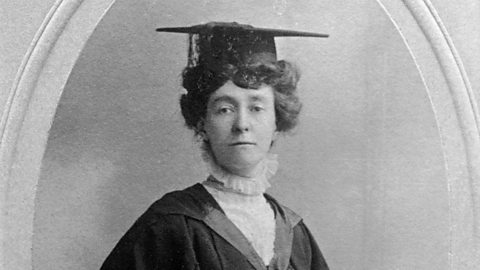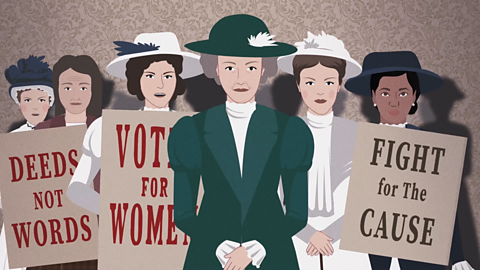Key points
- At the start of the 1800s, women in Britain didn’t have the right to vote. They also had very little legal protection and few rights to education or work.
- By the end of the 1800s there was growing support for the campaign for women’s right to vote.
- Two main campaign groups emerged, the SuffragistsThe name given to women using peaceful protest to try and win the right to vote. and the SuffragettesThe name given to groups of women using direct action and more aggressive methods to try and win the right to vote..
Video about the fight for female suffrage
Narrator: Through the 19th century, the electoral system went through many changes, but one constant remained. Women were not allowed to vote in national elections. In 1867, when Parliament was debating about whether to give working men the vote, John Stuart Mill suggested that women should also be allowed. But Parliament, which was made up entirely of men, rejected it. Women around the country set up Women's Suffrage Groups to campaign for the right to vote.
In 1897, the National Union of Women's Suffrage Societies was formed to bring these groups together. They were commonly known as the Suffragists, led by Millicent Fawcett. They campaigned by arguing their case with MPs, presenting petitions and organising meetings. But many male MPs still held strong views about the role and position of women in society and didn't think they should be allowed to vote. By 1900, there had been 15 failed attempts to get a bill through Parliament.
Some Suffragists became disillusioned and formed a new group who used more aggressive tactics: the Women's Social and Political Union. Led by Emmeline Pankhurst and known as the Suffragettes, they started a campaign of demonstrations and violent action against property. This included the death of Emily Davison as she protested during a famous horse race. The Suffragettes had raised the profile of the issue, but they had also lost the support of many, because of their anti-social actions.
At the outbreak of World War One with many men away fighting in Europe, women played a critical role in filling their jobs and sustaining the war effort. And the view that women should be allowed to vote became more widely accepted. The representation of the People Act of 1918 gave some women the right to vote. And finally in 1928, all women over the age of 21 were given the same voting rights as men.
Women’s rights at the start of the 1800s
Men and women were not equal in the 1800s. Women had very few rights in the eyes of the law and they were not allowed to vote. Women were expected to marry a man, have children and look after the home. When a woman got married, any property she owned passed into the ownership of her husband. Divorce was very difficult in the 1800s and there was limited legal protection against domestic violence.
Employed working class women often worked in low paid jobs, such as in the new industrial mills and factories, or in domestic serviceCooking, cleaning, childcare, gardening and personal service.. Very few middle-class women worked and once they were married, any money they earned became the property of their husband. It was very difficult for women to get a university education to access well-paid jobs such as doctor, architect or lawyer. In 1865, Elizabeth Garrett-Anderson became the first woman to be a qualified doctor in Britain. By 1900, there were still only 200 female doctors in Britain.
Early attempts at voting reform
In the mid-1800s, some women started to campaign for the right to vote, commonly referred to as women’s suffrageThe right to vote in elections.. Though many men opposed the women’s suffrage movement, there were some men who supported the campaign.
In 1832 Mary Smith, from Yorkshire, petitioned Member of Parliament (MP)Member of Parliament - someone who is elected to represent the people of a particular area of the country in government. Henry Hunt that unmarried women should have a vote as they paid their own taxes. Henry Hunt was mocked by fellow MPs when he presented this petition to Parliament.
John Stuart Mill was a member of parliament who wrote a book in 1869 called The Subjection of Women, in which he argued that women should be treated as equal to men. In 1867, Mill had put forward an amendmentA change suggested to a proposed law by an MP when the issue is debated in parliament. to the Reform Act that would have given women the right to vote on the same terms as men. This was defeated by 196 votes to 73. It did, however, help raise awareness of the issue of women’s right to vote.
Who were the suffragists?
Following the 1867 vote, the London Society for Women’s Suffrage was formed. Their aim was to peacefully protest and campaign for the right for women to vote. Groups similar to this were set up across the country, and in 1897 they were joined together to form the National Union of Women's Suffrage Societies (NUWSS), led by Millicent Fawcett. She was the sister of Elizabeth Garrett-Anderson, the first female doctor in the UK.
The NUWSS used a range of tactics to raise awareness for their campaign, such as:
- Petitions
- Writing letters to politicians
- Speeches
- Posters
Over time they won some publicity, and their membership grew, but by 1903 some women were increasingly frustrated at the lack of progress the NUWSS was making. Lack of action from Parliament meant that some campaigners felt that more aggressive action was needed.
Who were the suffragettes?
In 1903, Emmeline Pankhurst, and her daughters Christabel and Sylvie, formed the Women’s Social and Political Union (WSPU). They became known as the suffragettes. Their slogan was ‘Deeds not words.’
The suffragettes wanted to use direct action as they believed the peaceful methods of the suffragists were ineffective. Suffragettes used tactics such as:
- Chaining themselves to the railings of Buckingham Palace. Queen Victoria had called the campaign for women’s suffrage a ‘mad and wicked folly.’
- Burning down the homes of MPs who opposed women’s suffrage.
- Burning down churches. The suffragettes felt the Church of England was opposed to women’s suffrage.
- Breaking shop windows on Oxford Street, the main shopping street in London.
The government decided to take a hard line when the WSPU became more militant. Women were banned from political meetings and women who engaged in violence were imprisoned.
Women’s experiences of the suffrage movement
The experiences of working-class women campaigning differed from those from middle- and upper-class backgrounds. For example, working-class women were subjected to harsher treatment in prison. Middle class women were often protected by their family connections, and received softer prison conditions.
Race also played a part in women’s experiences of the suffrage movement. The suffragettes were mostly made up of white women but many women from ethnic minorities were active campaigners. Sophia Duleep Singh was of Indian origin and born in London. She was a prominent suffragette in the WSPU and a key figure in the campaign to refuse paying taxes. Unlike some suffrage movements elsewhere in the world, Britain’s campaign did not discriminate against race and supported all women’s right to vote.
Activity - Sort these statements
What was the 1913 Cat and Mouse Act?
Suffragettes were regularly arrested for their actions. They continued their direct action from prison and some women started going on hunger strikeA form of protest where a person refuses to eat until demands are met.. This caused a problem for the government as they did not want these prisoners to become martyrA person who suffers greatly or is killed for their beliefs or principles.. To combat this, authorities approved the force feeding of women on hunger strike. This was traumatic and risked serious harm or even death, but the practice continued for four years, despite an increase in public concern.
In 1913, the government passed the ‘Cat and Mouse Act.’ This was a law that women could be temporarily released from prison when they were becoming ill from refusing to eat. When they were recovering and eating again, they would be arrested and sent back to prison.
Who was Emily Davison?
In 1913, a suffragette called Emily Davison went to the Derby at Epsom, one of the most famous horse races in the world. She walked onto the racetrack in front of King George’s horse, Amner. She was carrying a WSPU sash and was hit by the horse, suffering serious injuries. She later died in hospital.
Some historians have suggested she had intended to attach the sash to the horse’s bridle to promote the movement for women’s suffrage to the large crowd. Regardless of her intention, it shows the dangerous situations women were willing to put themselves in to further the suffrage movement.
Newspaper coverage of the incident was initially very negative, but her funeral was attended by thousands of people and saw a change in attitude.

Image caption, Emily Davison had been a teacher, but gave up her career to focus on campaigning for the WSPU
Image caption, Thousands of people lined the streets for Emily Davison's funeral
1 of 2
Who was more effective: the suffragists or the suffragettes?
This is a question of historical interpretation.
The suffragette movement was formed because they felt the suffragists and their peaceful campaigning was being ignored by politicians. Their slogan 'Deeds not words' showed how they wanted to use direct action that couldn’t be so easily ignored by the government.
The suffragists felt the suffragettes were damaging the campaign for women’s suffrage. Some argued that the government would be less likely to give in to violent protest as it might encourage other groups to use similar methods.
The fact that there were two separate groups campaigning in different ways could also be seen as damaging to the movement. Opponents to women’s suffrage could point to the division as being a weakness.
Which campaign do you think was more effective?
Test your knowledge
Play the History Detectives game! gamePlay the History Detectives game!
Analyse and evaluate evidence to uncover some of history’s burning questions in this game.

More on The fight for female suffrage
Find out more by working through a topic
- count2 of 2
